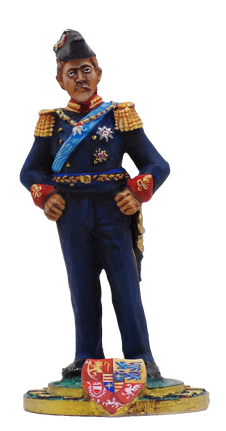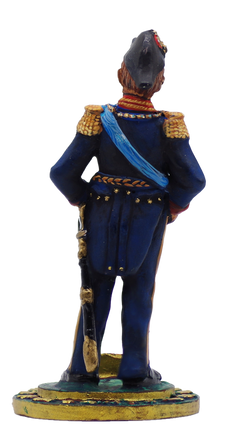
Friedrich Ferdinand
Duke of Schleswig-Holstein
Friedrich Ferdinand, Duke of Schleswig-Holstein-Sonderburg-Glücksburg, then Friedrich Ferdinand, Duke of Schleswig-Holstein (12 October 1855 – 21 January 1934), was the fourth Duke of Schleswig-Holstein-Sonderburg-Glücksburg and became the fifth Duke of Schleswig-Holstein in 1931 and the head of the House of Oldenburg. Friedrich Ferdinand was the eldest son of Duke Friedrich von Schleswig-Holstein-Sonderburg-Glücksburg (1814-1885) and his wife Princess Adelheid Christine zu Schaumburg-Lippe (1821-1899), second daughter of Prince Georg Wilhelm and Princess Ida Karoline Luise von Waldeck-Pyrmont. He attended the Vitzthumsche Gymnasium in Dresden. He embarked on an officer's career in the Prussian army and served in the Fusilier Regiment No. 86 in Flensburg, the Hussar Regiment No. 14 and the Infantry Regiment No. 85, among others. During his service, he rose to the rank of General of Cavalry à la suite. In 1894, Friedrich Ferdinand became a hereditary member of the Prussian House of Lords. At the turn of the 19th and 20th centuries, his estate of around 4,500 hectares was one of the largest estates in the province of Schleswig-Holstein, having been expanded to include several estates in Schwansen. Around 1600 people lived on his estate and secured the economic circumstances of the House of Schleswig-Holstein-Sonderburg-Glücksburg. Between 1922 and 1923, he transferred his family's previous main residence, Glücksburg Castle, to a foundation of the ducal house

and opened it to the public as a museum. The general administration of the estate moved its headquarters to Grünholz in 1928. Friedrich Ferdinand succeeded his father, who had died in 1885, and became the last nominal (non-reigning) Duke of Schleswig-Holstein-Sonderburg-Glücksburg. In 1931, he succeeded his cousin Albert von Schleswig-Holstein-Sonderburg-Augustenburg, the last duke from the Schleswig-Holstein-Sonderburg-Augustenburg line, as head of the House of Schleswig-Holstein. Friedrich Ferdinand married Princess Karoline Mathilde of Schleswig-Holstein-Sonderburg-Augustenburg, daughter of Frederick VIII, Duke of Schleswig-Holstein-Sonderburg-Augustenburg and his wife Princess Adelheid of Hohenlohe-Langenburg (and sister of Augusta Victoria, German Empress), on 19 March 1885 at Primkenau. Friedrich Ferdinand and Karoline Mathilde had six children.

The Royal Danish Navy (Danish: Søværnet, lit. 'The Navy') is the sea-based branch of the Danish Armed Forces. During the period 1509–1814, when Denmark was in a union with Norway, the Danish Navy was part of the Dano-Norwegian Navy. Until the copenhagenization of the navy in 1801, and again in 1807, the navy was a major strategic influence in the European geographical area, but since then its size and influence has drastically declined with a change in government policy. The history of the Danish navy began with the founding of a joint Dano-Norwegian navy on 10 August 1510, when King John appointed his vassal Henrik Krummedige to become "chief captain and head of all our captains, men and servants whom we now have appointed and ordered to be at sea". The primary task of the fleet in the first period of its existence was to counter the power of the Hanseatic League and secure control in the Baltic Sea. The fleet was expanded to be one of the largest in Europe under the direction Christian IV with 50-105 larger warships and a large number of brigs and sloops, numbering in total around 75. In the 17th and 18th centuries during the period of absolutism its primary aim was to control the Strait of Øresund against
the Swedish Empire. In this period it consisted of 45 ships of the line with an average of 60 guns, plus 20-40 frigates, large enough to counter the Royal Swedish Navy at the time. The number of guns on the ships of the line was smaller, a feature only the Dano-Norwegian navy had- different from the average number of cannons mounted on warships of the great sea powers of the time but it was partly a deliberate decision of the admiralty, in order to make the ships able to navigate in the countless narrow waters around the Danish isles. The Napoleonic Wars also saw the construction of nearly 200 gunboats during the Gunboat War with the United Kingdom after the British decisively defeated the Dano-Norwegian fleet and captured their entire navy. The Bille Family with Steen Andersen Bille had a large role in the reconstruction of the Dano-Norwegian fleet. The navy was considered to be the King's personal property, and "the King's waters" consisted of the sea off Denmark, Norway the Faroe Islands, Iceland and Greenland, large parts of the Baltic, the waters east of the North Cape and off Spitsbergen. For the entire period of its existence its main base was Holmen in Copenhagen, but on different occasions smaller task forces was stationed in Fredriksvern in Norway and in Glückstadt. In 1814, Denmark and Norway were separated relatively peacefully, after more than 300 years together. At the same time, the Common Fleet was split into the Royal Danish Navy and the Royal Norwegian Navy. The navy was slowly rebuilt, but it was nowhere near its former size. Faith was nevertheless placed in the navy, interests in Africa and the Caribbean still receiving considerable attention. In 1845, a two-year research expedition was launched on the corvette Galathea. In the Second Schleswig War (1864), the navy was still relatively small and old-fashioned, even though the Prussian Navy was even smaller. Only a few steam vessels were at hand and these had a large impact on the war, in the end Prussians were not very successful at sea. As a result, it was considered necessary for the navy to be modernised. By the outbreak of World War I (1914), the Danish navy was a very modern fleet, mainly equipped with armoured steam ships and only a very few sailing ships.

The House of Schleswig-Holstein-Sonderburg-Glücksburg, also known by its short name as the House of Glücksburg, is the senior surviving branch of the German House of Oldenburg, one of Europe's oldest royal houses. Oldenburg house members have reigned at various times in Denmark, Norway, Sweden, Iceland, Greece, several northern German states, Russia and the United Kingdom. It takes its name from the family seat in Glücksburg, a small town in Schleswig-Holstein, Germany. Current monarchs King Harald V of Norway and King Charles III of the United Kingdom, as well as the former Queen of Denmark Margrethe II and former queens consort Anne-Marie of Greece and Sofía of Spain, are patrilineal members of cadet branches of the House of Glücksburg. The Danish royal family continues using the name Glücksburg, although the present King descends patrilineally from the Monpezat family. Glücksburg is a small coastal town on the German southern side of the fjord of Flensburg that divides Germany from Denmark. In 1460, Glücksburg came, as part of the conjoined Dano-German duchies of Schleswig and Holstein, to Count Christian of Oldenburg whom, in 1448, the Danes had elected their king as Christian I, the Norwegians likewise taking him as their hereditary
king in 1450. In 1564, Christian I's great-grandson, King Frederick II, in re-distributing Schleswig and Holstein's fiefs, retained some lands for his own senior royal line while allocating Glücksburg to his brother Duke John the Younger (1545–1622), along with Sønderborg, in appanage.[4] John's heirs further sub-divided their share and created, among other branches, a line of Schleswig-Holstein-Sonderburg dukes at Beck (an estate near Minden bought by the family in 1605), who remained vassals of Denmark's kings. By 1825, the castle of Glücksburg had returned to the Danish crown (from another ducal branch called Glücksburg, extinct in 1779) and was given that year by King Frederick VI, along with a new ducal title, to his kinsman Frederick of Schleswig-Holstein-Sonderburg-Beck. Frederick suffixed the territorial designation to the ducal title he already held, in lieu of "Beck" (an estate the family had, in fact, sold in 1745). Thus emerged the extant Dukes of Schleswig-Holstein-Sonderburg-Glücksburg. The Danish line of Oldenburg kings died out in 1863, and the elder line of the Schleswig-Holstein family became extinct with the death of the last Augustenburg duke in 1931. Thereafter, the House of Glücksburg became the senior surviving line of the House of Oldenburg. Another cadet line of Oldenburgs, the Dukes of Holstein-Gottorp, consisted of two branches which held onto sovereignty into the 20th century. But members of the Romanov line were executed in or exiled from their Russian Empire in 1917, while the Grand Duchy of Oldenburg was abolished in 1918, although its dynastic line survives.
Awards: Collar, sash and star of the Order of the Elephant (Elefantordenen), star of the Oldenburg House and Merit Order of Duke Peter Frederick Louis (Oldenburgischer Haus- und Verdienstorden des Herzogs Peter Friedrich Ludwig).






